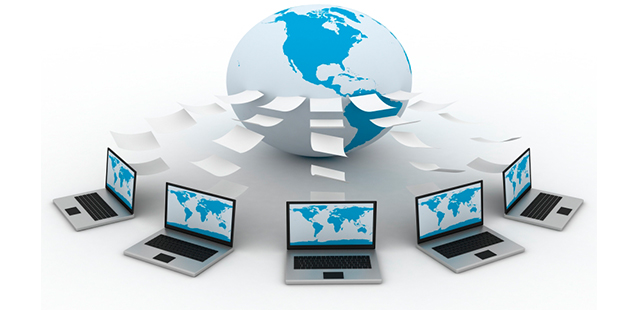The dynamic development of information and communication technologies, penetrating into all spheres of the vital activity of modern society, has so changed the attitude to the methods of obtaining and the volumes of data of interest, the possibility of instant audio or visual communication with almost any point of the Earth and near space, that we can already talk about the evolution of information consciousness person.
Altered reality
Moreover, this change in consciousness occurred rapidly, literally within a decade, which does not mean the spontaneity of the causes that gave rise to such a reaction.
In turn, the personal transformation forces the global restructuring and modernization of hitherto sufficiently inert state institutions that determine the future development of countries in the legal, social, economic and other areas.
Computer science and communications: from different definitions to a single whole
More recently, the phrase "the development of information and communication technologies" was used only with the union "and", and not with a hyphen between words, since this was a question of the development of various industries.
Communication technologies are defined by the methods, tools, and methods used to facilitate communication. Information is used to create, record, modify and display transmitted content. Each of them was developed as a separate technological area and an independent industry until the 1970s, until computer science began to be used in telecommunication networks. The term ICT (information and communication technology) was adopted to refer to the convergence (from lat. Convergo - "bring together") of these technologies and industries. Today, this term defines electronic computer communication methods used as part of or together with modern telecommunication networks.
A brief history of ICT
With the launch of the first commercial copies of the electric telegraph in 1837 and the telephone in 1876, it became possible to communicate over wires over long distances almost instantly, which was much more progressive than earlier communication methods - knocking on the rail, signal fires and carrier pigeons.

Wireless telegraphy (1895), shortwave radio (1926), and then more reliable high-frequency radio waves (1946) overcame the physical limitations of the need to connect a signal source and receiver via wire or cable. Ultrashort waves (1957) provided higher-power communication channels for transmitting television signals and laid the foundation for the development of satellite and space communications. In the 1970s, the first mobile phones were developed, and basic technologies arose for the advent of the World Wide Web. Both mobile and Internet communications have developed rapidly since their introduction in the 1980s to the point that mobile Internet access (such as smartphones) has become the dominant and fastest-growing form of communication.
Information + Communication = Future
The prospects for the development of information and communication technologies in the 21st century are aimed specifically at expanding the parameters and capabilities of communication equipment and facilities. In the 1990s and 2000s, the term “technological convergence” became the leitmotif of the principle of applying this symbiosis of technology to integrate previously independent means of communication, such as telephone, radio, television, newspapers and computer data, into a single World Wide Web operating on the basis of broadband telecommunication high capacity networks.
ICT Applications
ICT technologies continue to improve, and the Internet develops with them, covering all large territories. The scope of modern software products has gone far beyond the information and communication industries, and it is already difficult to name the scope of activities deprived of their attention. Expanding the ability to collect huge volumes of detailed information (metadata) and creating networks of communication devices allows you to use a lot of useful applications in areas such as training, healthcare, environmental monitoring, etc., but at the same time, alas, provides additional loopholes for remote tracking users from interested parties or organizations.
Information as a World Currency
It has long been recognized that advanced communications technology can provide tremendous economic, political and military benefits. Information is power. The use of information and communication technologies is capable of directing the vector of political and social moods within society in the required direction by the authorities, and this applies not only to the internal aspects of the state, but also to foreign policy. Therefore, there is no big secret that the bulk of research and development in this area was funded and is still funded from the military budgets of the most influential powers.
Today, for any state, the use of ICTs is the cornerstone of industrial and political strategies aimed at developing the national economy and uniting the country, as well as gaining advantages in a competitive global political economy.
Caution Internet!
ICT technologies are often presented as a panacea for solving economic and social problems, guaranteeing new benefits and freedoms both in the workplace and in social life. However, not all effects of new technologies can be foreseen. In a competition to promote the benefits of new technologies, potential weaknesses and problems of adaptation are too often ignored, and sometimes simply hidden. Consider a small example. On the one hand, for Russia, as the largest state in terms of occupied area in the world with a relatively low population density, the question of creating a global information network as a means of unifying the country is more relevant for anyone. This work was carried out and is now actively conducted by both state and commercial organizations. Thousands of kilometers of fiber optic cable are laid, suspended and stretched annually, giving the people of the most remote corners of the country the opportunity to communicate and access the media benefits of civilization. However, far from always this bottomless source of information is filled with adequate content. The younger generation, and this is the most active segment of Web users, is attracted by dynamic, vibrant and professional content, which is not so much among national media resources.
That is, the promotion of information and communication technologies should be in solidarity with the creation of their own and, most importantly, high-quality media product promoted in the network space.
ICT Growth Challenges
The uncritical adoption of technological change does not take into account its problems and traps. For example, the excessive commercialization of the Internet, when the dominance of private desire for profit is the main trend that determines the development of information and communication technologies, while the creation of promising social areas (new educational opportunities, more democratic participation in political processes, distance medicine) is pushed to the back plan, for the sake of momentary benefit.

The pitfalls of ICT include a significant reduction in the level of confidentiality and, as a consequence, an increase in crime using personal information received from users. The problem of the methods by which technologies contribute to changing patterns of employment and incomes of the population remains topical. While creating new jobs, the Internet at the same time “buried” more than one hundred professions, and as analysts predict, this is only the beginning of large-scale changes in the labor market. For a variety of reasons, not all people who are left without work are able to quickly find an equivalent substitute for the cause of their whole life, and this is already a problem on a national scale.
What is good, what is bad - the choice is ours
Although these concerns are real, they are by no means unique to a particular state. And the solution of the question of where the development paths of the revolution in the field of the application of information and communication technologies (in the interests of their citizens or large businesses) lead, depends only on the priorities of each country's state policy. Achieving maximum opportunities, minimizing undesirable consequences and finding the right balance between private and public activity is a serious problem, especially in an economic environment dominated by powerful private corporations.
New Learning Technologies
Let us consider in more detail the segment of information and communication training technologies as one of the most significant areas determining the development of ICT, as well as its very existence in the future. The prospects of technology are inextricably linked with changes within a specific person, the ability to take new things, fully use and develop them, becoming, as a result, a cell of the information society, where the level of well-being will be determined by information and the ability to use it wisely. In this context, today the education system is faced with the task of developing methods and creating conditions for the maximum adaptation of students to the requirements of modern life, the definition and development of personal abilities, provided that high basic knowledge is obtained. Achieving these goals implies the use of a whole range of measures: technical support, the development of didactic materials, the creation of advanced teaching technologies, professional training of teaching staff and much more.
Harvard at home
A huge potential has been gained in recent years, a widespread distance learning, which has reached a completely different level precisely thanks to ICT. In the lessons, pupils and students get a unique opportunity to study the subject of interest from the best teachers, receiving the most complete information, which for most comers, for various reasons, was virtually unattainable.

This form of training, along with traditional methods, technologies and methods of education, actively uses educational knowledge bases of the Internet, therefore, equipping educational institutions with information and communication technologies is one of the important elements of modernization of secondary and higher schools. The education system is becoming part of the information space, in line with the growing demands of a developing society. Trends in the creation of common economic zones and similar goals of international organizations will inevitably activate the processes of globalization and improvement of the education system of any member state of such an association.
Global implications
ICTs are reminiscent of a fantastic teleport capable of connecting access points remote at a great distance in time and space with the ability to transmit and collect information of a large volume and variety.
However, the full functioning and maintenance of such a miracle of technology requires enormous costs, special equipment and qualified specialists. And, as they say, who pays is the conductor, because the main beneficiaries of this activity are often multinational corporations that use ICTs to expand their sphere of influence, increase sales markets and instantly transfer financial resources around the world.
Urgent ICT Issues
For many, especially developing countries, Internet expansion can pose a threat to domestic production and employment, national sovereignty, and local culture. Although the proliferation of mobile phones around the world has enabled millions of people in poor countries to access basic communication services for the first time, there are still many places on earth where people are deprived of this opportunity. Closing this “information gap” is the goal of initiatives of international, state and some non-governmental organizations. The only question is whether this desire is disinterested.